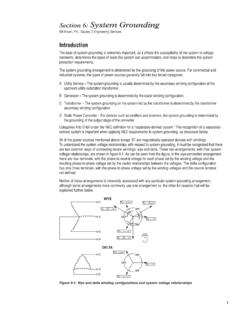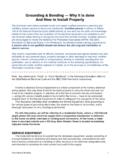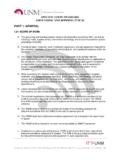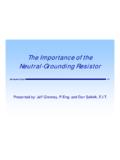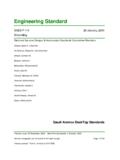Transcription of PRINCIPLES OF ELECTRICAL GROUNDING - Pfeiffer Eng
1 PRINCIPLES of ELECTRICAL GROUNDING By: John C. Pfeiffer , Pfeiffer Engineering Co., Inc. PRINCIPLES of ELECTRICAL GROUNDING John Pfeiffer , Abstract: This is a discussion of the basic PRINCIPLES behind GROUNDING systems and how GROUNDING is related to safety and the effective operation of circuit protection devices such as fuses and circuit breakers. The discussion moves quickly from a basic study of GROUNDING to simple examples of a single building installation and onto facilities with multiple buildings and structures. Finally the discussion will briefly cover GROUNDING as it applies to lightning protection and the control of static electricity. Introduction: GROUNDING to most engineers, technicians and electricians is a simple subject and little attention is paid to it other than knowing that something is required.
2 To some people there are grounds and then there are Clean Grounds . Thirty years ago when computers were relatively new, there were many approaches to GROUNDING , particularly for electronics and computers. Some of these approaches established what was called a Clean Ground which was often isolated from the power grounds. Many of these ideas have been proven to be ineffective and sometimes dangerous to equipment and personnel. As frequencies became higher and higher (computer speeds faster and faster) research accelerated into the subject of GROUNDING , shielding, EMI, lightning protection and static electricity. The research resulted in the basic science behind GROUNDING . This subject is not as simple as once thought and one needs a clear understanding of the basic PRINCIPLES . First, the ground or GROUNDING of a circuit is a misnomer.
3 For most purposes the term means earthing or connecting the circuit to earth. In actuality, it=s connecting the circuit to a common point of reference; for most systems that is the earth. GROUNDING =s main purpose is to provide a common point of reference between various sources of ELECTRICAL energy, Different power systems - Public Utilities, on-site generation, battery systems Different voltage systems - 138,000v, 13,800v, 480v, 120v, etc. Different energy sources - ELECTRICAL Energy, Lightning, Static Electricity, RF Energy In any discussion of the GROUNDING of ELECTRICAL systems, particularly as it applies to power systems, there also needs to be a consideration of how the GROUNDING system relates to overcurrent protection. They go hand in hand. There are also a number of misconceptions that affect how a ground system works.
4 The following facts are generally not known or are misunderstood. The earth is NOT always a good ground. What is acceptable at 60 Hz does not always work at high frequencies. The interconnection of systems with even large conductors may be ineffective when 8 Copyright Protected Pfeiffer Engineering Co., Inc. All Rights Reserved 2001 Page 2 of 43 PRINCIPLES of ELECTRICAL GROUNDING John Pfeiffer , installed improperly - ground loops around buildings and interconnecting buildings are not enough - the ground conductor must be run in a conduit with the phase conductors (ground conductors act as an inductor when outside of the conduit). Circuit breakers and fuses, even though sized properly do not always protect. GROUNDING shields can cause major problems. Most of the time ground only one end, but not always.
5 Some circuits require both ends grounded. New construction methods and materials are causing real problems - elimination of a structural element that has a secondary benefit as an ELECTRICAL conductor is causing ELECTRICAL problems. An improperly installed lightning protection system can cause more damage then not having any lightning protection. Safety: In actuality, GROUNDING =s purpose is a lot more than providing a common point of reference. It is the key to SAFETY. That is, the protection of Personnel Equipment Facilities When considering protection of personnel, equipment and facilities against ELECTRICAL hazards there is a NEED TO CONSIDER both GROUNDING and Overcurrent Protection and how they relate. They go hand in hand. A facility=s ELECTRICAL protection systems are intended to: Protect Personnel from - Electrocution - Fire Protect Equipment and Facility from - Failure - Fire Protect ELECTRICAL Circuit from - Cable Failures For the protection systems to do as intended, they must first work; and second they must work fast enough to eliminate or at least minimize damage.
6 This is where proper GROUNDING comes to play. Another fact, which this author has observed, is that in most cases, accidents & failures occur because of TWO events or failures that exist at the same time. For example, a poor ground does not cause a problem in itself, but coupled with a short circuit, you have an accident. Likewise, an improperly installed ground system (with proper circuit protection) may not cause a problem until a short circuit occurs, the circuit breaker does not open, and the equipment is destroyed. The reduction and potential elimination of many ELECTRICAL problems is a function of proper 8 Copyright Protected Pfeiffer Engineering Co., Inc. All Rights Reserved 2001 Page 3 of 43 PRINCIPLES of ELECTRICAL GROUNDING John Pfeiffer , GROUNDING . GROUNDING is, in essence, the control of abnormal voltages or currents through the proper application of Ohm=s Law: E = IR (Simplified Form) E = IR + jIXC + jIXL GROUNDING is the control or minimization of R in order to reduce the effects of E & I.
7 Improper GROUNDING can cause more harm than no GROUNDING . Misunderstood GROUNDING often leads to the installation of improper GROUNDING systems that are either ineffective, or even worse, dangerous. Electric Shock: An ELECTRICAL shock (electrocution) occurs when two portions of a person=s body come in contact with ELECTRICAL conductors of a circuit which is at different potentials, thus producing a potential difference across the body. The human body does have resistance and when the body is connected between two conductors at different potentials (voltage) a circuit is formed through the body and current will flow. When the human body comes in contact with only one conductor, a circuit is not formed and nothing happens. When the human body comes in contact with circuit conductors, no matter what the voltage is, there is a potential for harm.
8 The higher the potential difference the more the damage. The effect of an ELECTRICAL shock is a function of what parts of the body come in contact with each conductor, the resistance of each contact point, the surface resistance of the body at the contact, as well as other factors. When the ELECTRICAL contact is such that the circuit path through the body is across the heart, you have the greatest potential for death. As shown in Figure 1, the human body=s resistance varies from as low as 500 ohms to as high as 600,000 ohms. As the skin becomes moist, the contact resistance drops. If the skin is moist, due to sweat that contains salt, the resistance drops further. Figure 1 illustrates the amount of current that can flow through the human body at three different potential differences across the body. Also shown is the effect of different current levels, both AC and DC.
9 The ultimate effect is fibrillation, which causes the heart to stop, and results in death. When a high voltage such as 13,800v is involved, the body is literally cooked and, at times, explodes. Figure 1 also shows two stick figures, Safe Sally and Suzie Sizzle to illustrate how the human body can become electrocuted. The use of female names is only to provide names that are easy to remember and which rhyme with safe and sizzle and in no way intended to indicate that women are unsafe or more easily shocked. 8 Copyright Protected Pfeiffer Engineering Co., Inc. All Rights Reserved 2001 Page 4 of 43 PRINCIPLES of ELECTRICAL GROUNDING John Pfeiffer , ISAFE SALLYSUZIE SIZZLEHUMAN BODYZ = 500 to 600,000 OHMS(DEPENDS ON SKIN MOISTUREAND OTHER FACTORS)I = 250mA to @ 120 VACI = 550mA to @ 277 VACI = 960mA to @ 480 VACELECTRIC SHOCKPERCEPTION LEVEL1mA2mAAC @ 60 HzDCNO-LET-GO LEVEL15mA300mAFIBRILLATION LEVEL500mA500mAFIBRILLATION LEVEL75mA400mA@ SECONDS@ SECONDSSHOCK001I~ FIGURE 1 ~ 8 Copyright Protected Pfeiffer Engineering Co.
10 , Inc. All Rights Reserved 2001 Page 5 of 43 PRINCIPLES of ELECTRICAL GROUNDING John Pfeiffer , SHOCK018 BASIC CIRCUIT(PHASE-TO-PHASE or PHASE-TO-NEUTRAL)120 VLOADIIXX120 VIILOADR1R1R1 LRR1I=ERLI ~(SIMPLIFIED)R1R1=ILI~RLRE+(SIMPLIFIED)R 21 RESRSCCRCSorEE++SRLCR+~ FIGURE 2 ~8 Copyright Protected Pfeiffer Engineering Co., Inc. All Rights Reserved 2001 Page 6 of 43 PRINCIPLES of ELECTRICAL GROUNDING John Pfeiffer , SHOCK019 BASIC CIRCUIT(PHASE-TO-GROUND)120 VLOADXXIF ' ' OR ' ' IS HIGHTHE CIRCUIT BREAKERWILL NOT OPENWILL CAUSE A FIRELOW ' ' WITH HIGH ' 'R1R1 RERSCI=ERSC+RE+1R~ FIGURE 3 ~CSRRECSRRE8 Copyright Protected Pfeiffer Engineering Co., Inc. All Rights Reserved 2001 Page 7 of 43 PRINCIPLES of ELECTRICAL GROUNDING John Pfeiffer , SHOCK020 WHAT IS THE MAXIMUMXXSHORT120 VCURRENT FLOWIN A SHORT CIRCUIT?
